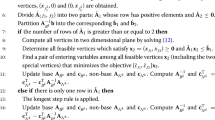Abstract
This paper shows the relationship between degeneracy degrees and multiple solutions in linear programming (LP) models. The usual definition of degeneracy is restricted to vertices of a polyhedron. We introduce degeneracy for nonempty subsets of polyhedra and show that for LP-models for which the feasible region contains at least one vertex it holds that the dimension of the optimal face is equal to the degeneracy degree of the optimal face of the corresponding dual model. This result is obtained by means of the so-called Balinski—Tucker (B—T) Simplex Tableaus. Furthermore, we give a strong polynomial algorithm for constructing such a B—T Simplex Tableau when a solution in the relative interior of the optimal face is known. © 1998 The Mathematical Programming Society, Inc. Published by Elsevier Science B.V.
Similar content being viewed by others
References
E.D. Nering, A.W. Tucker, Linear Programs and Related Problems, Academic Press, New York, 1993.
A. Schrijver, Theory of Linear and Integer Programming, Wiley, Chichester, UK, 1986.
M.L. Balinski, A.W. Tucker, Duality theory of linear programs, a constructive approach with applications, SIAM Review 11 (1969) 347–377.
J. Telgen, Minimal representation of convex polyhedral sets, Journal of Optimization Theory and Applications 38 (1982) 1–24.
O. Güler, D. den Hertog, C. Roos, T. Terlaky, T. Tsuchiya, Degeneracy in Interior Point Methods for Linear Programming: A survey, Annals of Operations Research 46, pp. 107–138.
A.J. Goldman, A.W. Tucker, Theory of linear programming, in: H.W. Kuhn, A.W. Tucker (Eds.), Linear Inequalities and Related Systems, Annals of Mathematics Studies, No. 38, Princeton University Press, Princeton, NJ, USA, 1956, pp. 53–97.
G. Sierksma, Linear and Integer Programming; Theory and Practise, Marcel Dekker, New York, 1996.
H.J. Greenberg, An analysis of degeneracy, Naval Research Logistics Quarterly 33 (1986) 635–655.
O.L. Mangasarian, Uniqueness of solution in linear programming, Linear Algebra and its Applications 25 (1979) 151–162.
C. Roos, T. Terlaky, J.-Ph. Vial, Theory and Algorithms for Linear Optimization, Wiley, Chichester, UK, 1997.
N. Megiddo, On finding primal- and dual-optimal Bases, ORSA Journal on Computing 3 (1991) 63–65.
R.E. Bixby, M.J. Saltzman, Recovering an optimal LP basis from an interior point solution, OR Letters 15 (1994) 169–178.
S. Zhang, On the strictly complementary slackness relation in linear programming, in: Ding-Zhu Du, Jie Sun (Eds.), Advances in Optimization and Approximation, Kluwer Academic Publishers, Dordrecht, 1994, pp. 346–361.
Author information
Authors and Affiliations
Rights and permissions
About this article
Cite this article
Tijssen, G.A., Sierksma, G. Balinski—Tucker simplex tableaus: Dimensions, degeneracy degrees, and interior points of optimal faces. Mathematical Programming 81, 349–372 (1998). https://doi.org/10.1007/BF01580088
Received:
Revised:
Issue Date:
DOI: https://doi.org/10.1007/BF01580088




